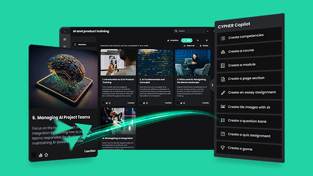Most people today live in a world of projects. No matter what we do for a living, work projects are everywhere. We need to do research and planning, work in teams, constantly adapt to feedback, all while trying to find the best solutions and keep within budgets.
And even life outside of work is full of projects. Whenever we need to bake a cake, plant a flower, paint a room, repair something around the house or organize a birthday party, we still need to do research and planning, communicate and collaborate with other people, constantly adapt to feedback and manage budgets.
I think I made it clear by now that the adult life is full of projects.
The education system is supposed to prepare students for the adult life. However, a lot of school work — of all levels — is still based on lectures, memorization capacity and standardized assessment. These are not exactly essential requirements for preparing students for the project-cluttered adult life. In fact, various theorists, authors and educators have expressed for some time that our formal educational institutions need more engaging, autonomous, authentic, and cooperative learning processes.
The logic behind this is the following: if the adult life means dealing with many and various projects, and schools are supposed to prepare students for the adult life, shouldn’t they adopt a project-based approach to education?
The answer is a resounding YES! The answer is project-based learning.
What does project-based learning mean?
Project-based learning — or PBL — is a teaching method in which students gain knowledge and skills by working for an extended period of time to investigate and respond to an engaging and complex question or problem. This is the official definition given by the Buck Institute for Education, or BIE.
Project-based learning is a viable solution for delivering instruction and since it’s based on the student’s learning objectives and needs, it paves the way to great academic results and significant student achievement.
By focusing students on a project, teachers put them on a path that deepens their knowledge and build skills they’ll need in the future, like critical thinking, collaboration, communication and creativity.
Project-based learning may be a better approach to education than traditional practices. A study conducted by Purdue University found that PBL can increase long-term retention of learning material and improve teachers' and students' attitudes toward learning. One explanation that researchers suggest is that both educators and learners are more actively engaged with the subject material.
Key design elements of project-based learning
The same Buck Institute for Education mentioned above goes on to explain the key design elements of project-based learning. But before going into that, one thing must be clear: any project should be designed based on student learning goals and critical skills development.
For example, if students have to learn how birds fly, they need to understand and gain knowledge on specific learning content on bird biology and the laws of physics. While going through the learning materials they need to put their brain to work and ask questions and explain what they understand, communicate with their peers and teacher, and collaborate within teams.
Challenging problem or question
The project must be designed around a problem to be solved or a question to be answered — and these need to be wrapped in an interesting way. Today we’re going to talk about birds bones. sounds way less interesting than Today you’re going to learn about how birds fly, from the Hummingbird to the Great American Eagle!, don’t you agree?
Sustained inquiry
Curiosity has no limits. Offer your students a challenging-enough problem or question and watch how they come up with a cascade of more questions.
- Why are bird bones empty inside?
- Actually, they’re not empty; there’s a channel-like structure in there.
- How come this channel structure helps them get off the ground?
- Does their beak have any role in flying?
Let them ask as many questions as they can think of, and encourage them to find the answers by themselves, using any resource they want.
Authenticity
The project should feature a real world context or at least to address students’ interests. Perhaps students who have a parrot as a pet might be interested in finding out how birds fly (or why chickens don’t), but any human being wonders at some point about the magic of flying. No matter what your project is about, you need to find and communicate the authentic part of it.
Student voice and choice
In project-based learning, students are allowed and encouraged to take the lead and make decisions about and along their learning journey. As long as they get involved in learning, it shouldn’t matter how much they read compared to watching videos, nor how much they work in teams or individually. This empowerment over their own learning process contributes to higher retention rates.
Reflection
Nothing is perfect. And when you do something for the first time or learn something for the first time, you realize there’s always a better way to do it. After reaching a learning outcome, everyone should look back:
- What was hard to get?
- Was there another easier way to reach the same result?
- What worked?
- What didn’t?
Both the students and you as a teacher should reflect upon these questions and draw some conclusions.
Critique and revision
This is focused more on the what didn’t work part and trying to figure out why. Multi-directional feedback is essential here, as identifying what could have been better is the first step in improving processes. Maybe a student got lost in doing research, maybe another one overestimated their knowledge and got a learning gap without realizing it. As long as students receive and, most importantly, use the feedback they get, they’ll be able to get better results faster on future occasions.
Public product
After they have gathered enough knowledge and understanding about how birds fly and how a Hummingbird is different than a Great American Eagle — or about anything else the project was about — students make their project work public by explaining, displaying and/or presenting it to people beyond the classroom. This authentic public product presented to a real-world audience is what distinguishes project-based learning from other teaching strategies.

Conclusion
Including project-based learning in face-to-face or online instruction usually has a positive impact over both the students and the educators. That’s why this approach is continually growing in the K-12 schools across the country.
The growing use of project-based learning materials in various classes fosters intrinsically motivated, independent researchers and thinkers that have higher chances of navigating successfully through the project-cluttered adult life.







